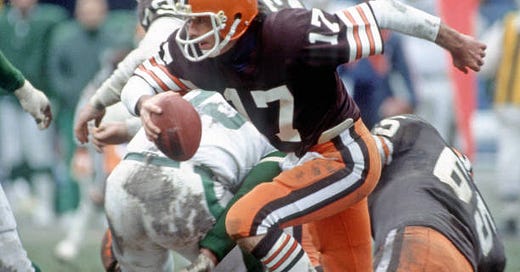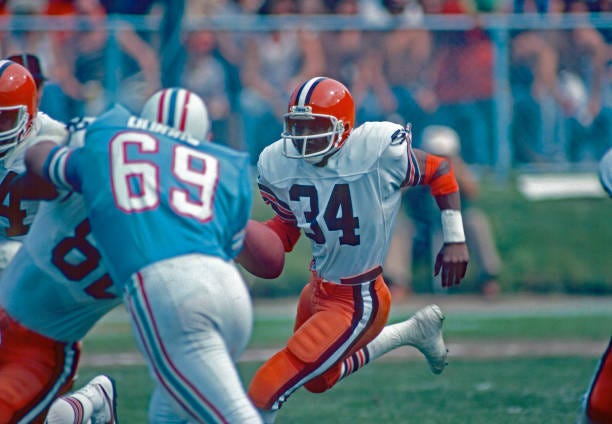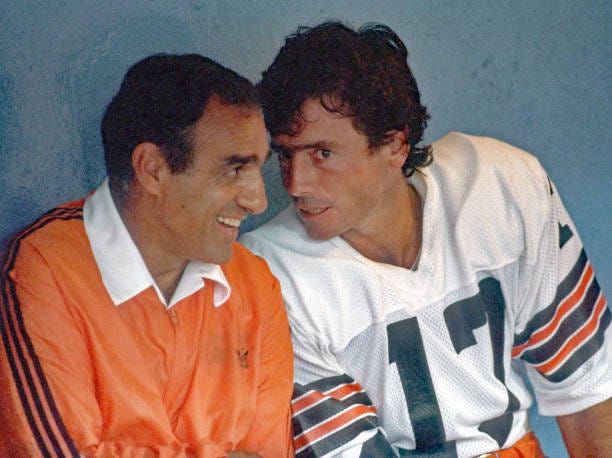Brian Sipe and the ‘Cardiac Kids:’ Recalling the 1980 Cleveland Browns
It’s been a long time since the Cleveland Browns were a Super Bowl-caliber team, but it hasn’t always been that way.
In 1980, the Browns were one of the league’s hottest teams. Coach Sam Rutigliano’s squad was coming off an 8-8 season in 1978 and a slight improvement to 9-7 in ’79. Could the Browns take the next step in ’80?
Led by veteran quarterback Brian Sipe, the upstart Browns finished 11-5 and claimed the AFC Central Division title. But the Browns, full of dramatics even then, didn’t exactly roll to a division title. Cleveland survived so many close games they were labeled the “Cardiac Kids.”
The Browns created a buzz at old Cleveland Municipal Stadium (the original Dog Pound), that season. However, their dream of reaching the first Super Bowl in franchise history would come to a crashing halt in the playoffs to a veteran team, also with championship aspirations.
Sipe lives up to the hype
After becoming Cleveland’s full-time starting QB in ‘78, Sipe, 31 years old in the fall of 1980, broke through with an excellent season.
Sipe earned the Associated Press Most Valuable Player award, earned All-Pro honors and a Pro Bowl selection. It would be the only time in his 10-year career Sipe would reach those achievements. Fans all over northeast Ohio were donning No. 17 jerseys that season.
Sipe completed 337 of 554 passes for 4,132 yards and 30 touchdowns with 14 interceptions. The veteran finished the season with a 91.4% passer rating. More impressive, Sipe engineered four game-winning drives and three fourth-quarter comebacks in ’80.
The Browns started out slow that season, losing to the Patriots and Oilers. Fans wondered what was wrong with Sipe. The signal-caller brushed off the critics, telling the Akron Beacon Journal, “Even George Brett goes 0-4 sometimes, doesn’t he?” That was the summer the Kansas City Royals icon nearly chased down the elusive .400 batting average mark.
While the Browns stumbled out of the gate, they turned it on at mid-season, winning five-straight. Sipe was the catalyst.
Pruitts lead backfield charge
In 1980, the Browns’ tandem of running backs proved vital to their success.
Mike Pruitt earned his second-straight Pro Bowl selection, rushing for 1,034 yards on 249 carries. The former Purdue star also grabbed 63 receptions for 471 yards and six TDs. Fellow running back Greg Pruitt (no relation) hauled in 50 receptions for 444 yards and five TDs.
While Sipe used the Pruitts often to rack up more than 4,000 yards, he also threw darts to a strong receiving trio. Wide receiver Reggie Rucker had 52 receptions for 768 yards and four touchdowns, while Dave Logan finished with 51 receptions for 822 yards, averaging more than 16 yards per catch. At tight end, Ozzie Newsome was developing into a threat. Coming off a fine season in ’79, Newsome hauled in 51 of Sipe’s passes for nearly 600 yards and three scores.
Cleveland also boasted a stellar offensive line, paving the way for the Pruitts and protecting Sipe. Three linemen, center Tom DeLeone, left tackle Doug Dieken and right guard Joe DeLamielleure, all made the Pro Bowl.
Leading the defense was veteran Lyle Alzado. The 6-foot-3, 255-pound defensive end was a first-team All-Pro selection in ’80.
Defensive coordinator Marty Schottenheimer’s 3-4 scheme was led by right outside linebacker Clay Matthews. Despite missing two games in ’80, Matthews collected 83 tackles.
Cornerbacks Clinton Burrell and Ron Bolton patrolled the backfield. Bolton had six interceptions, while Burrell had five.
Close, heart-pounding wins
The Cardiac Kids certainly lived on the edge in 1980.
On Oct. 5, a 19-16 loss to Denver put the Browns at 2-3. The frustrating setback to the Broncos lit a fire under Cleveland. Rutigliano’s squad rolled off five-straight victories, although four of them were extremely close wins. A tough 16-13 defeat to rival Pittsburgh Nov. 16 ended Cleveland’s hot streak.
The Browns won four of their last five regular-season games, beginning with a 31-7 rout of the Bengals, their most lopsided win of the season. The late-season run included hold-your-breath wins over the Vikings (28-23) and Bengals, this time putting up a fight, 27-24.
They also earned a 17-14 victory (and revenge) over Houston, which proved pivotal in the Central Division race. Bum Phillip’s Oilers also finished 11-5, but Cleveland had a better conference record, forcing Houston to travel to Oakland for a Wild Card playoff game. It did not turn out well for Bum and the boys. The Raiders smashed Houston 27-7, setting up a clash with the Browns at the Dog Pound.
Playoff heartbreak ends dream season
The Browns’ flair for dramatics led to a thrilling, heart-pounding season. It also led to sudden defeat in the playoffs.
Despite a brutally cold day along Lake Erie on Jan. 4, 1981, there was enthusiasm in the air. Cleveland was in the playoffs for the first time in eight years. The Browns were hosting the Raiders, a warm-weather team, and they had 77,000 faithful packed in Municipal Stadium for support. After the fabled Ice Bowl, it was the second-coldest playoff game in NFL history. It would get even chillier for the home team.
Losing 14-12 late in the fourth quarter, the Browns drove into Oakland’s red zone. On second down, Sipe, looking for Logan in the end zone, instead went to Newsome. Raider defensive back Mike Davis, however, had other plans. Davis swooped in front of Newsome, hauled in the interception and ended the Browns’ magical season.
Following the devastating loss, Rutigliano said it wasn’t one play that cost the Browns. It was the first time in 41 games Cleveland’s offense didn’t score a touchdown. Sipe, in the only playoff appearance of his career, struggled, completing 13 of 40 passes for 169 yards, with no TDs and three interceptions. The last one was a backbreaker.
Cleveland’s defense held Oakland to 208 yards and scored the Browns’ only touchdown on a 42-yard interception return by Bolton. Kicker Don Cockroft nailed two field goals, but also missed two and an extra-point, costing the Browns precious points.
After the game, Sipe told the Beacon Journal he was afraid of getting sacked on that fateful throw to Newsome. “I should have thrown it away,” he said. Rutigliano, who told Sipe he loved him after the dejected QB returned to the sidelines, told reporters it was Sipe’s competitive nature to try and make the game-winning throw.
Rutigliano also faced backlash for his play-calling. Instead of running the ball with Mike Pruitt and setting up a potential winning field goal, the coach chose to pass with a couple downs to spare. While Cockroft had missed twice earlier, Cleveland was in the Raiders’ red zone. Opportunities were there for them to run the ball, take time off the clock, and call on Cockroft for one more shot.
In the following day’s Beacon Journal, columnist Tom Melody ripped Rutigliano for his dare-devil play-calling. Melody wrote the coach relied too much on Sipe.
“Instead, he is a coach mesmerized by the oft-miraculous powers of (Sipe),” Melody wrote. “A coach whose idea of logic would be to jump out the window of his 24th-floor hotel room in order to get a breath of fresh air.”
The Raiders, riding a wave of momentum, upset the San Diego Chargers for the AFC Championship a week later. In late January, Oakland completed its championship season with a victory over the Eagles in the Super Bowl. The Browns were left wondering what might have been.
Aftermath – Sipe heads to rival league
Perhaps the devastating loss carried over into the following season, but whatever the case, the Browns stumbled to a 5-11 mark in ’81.
Cleveland wouldn’t be formidable again until ’86 with Schottenheimer at the helm. The Browns of the late ‘80s were a very talented team. But, more postseason devastation followed, denying Cleveland a trip to the Super Bowl.
Sipe spent his entire 10-year NFL career in Cleveland, leaving the Browns following the 1983 season. He finished with 154 TD passes, 149 interceptions and almost 24,000 yards.
Sipe engineered 17 fourth-quarter comebacks and 23 game-winning drives, including a league-leading seven in ’79.
After leaving Cleveland, Sipe played two seasons in the Unites States Football League with the New Jersey Generals and Jacksonville Bulls. He retired from pro football in 1985.
Mike Pruitt, a 1976 first-round draft pick, left the Browns after the ’84 season. He played for the Bills and Chiefs before retiring in 1986. Pruitt finished with 9,475 all-purpose yards and 51 touchdowns.
Greg Pruitt left Cleveland after the ’81 season. He played three more seasons with the Los Angeles Raiders, earning a Super Bowl ring in ’83, before hanging up the cleats. Pruitt reached the Pro Bowl five times and chalked up more than 13,000 all-purpose yards.
Ozzie Newsome had a Hall-of-Fame career, earning All-Pro honors in ’84. Newsome played his entire 13-year career in Cleveland, competing in 10 playoff games, never reaching that elusive Super Bowl. For younger fans, Newsome is known as the architect of the Baltimore Ravens’ long run of success, winning two Super Bowls in his reign as general manager.
Reggie Rucker made his mark with the Patriots before joining the Browns in ’75. He retired, after 12 seasons, in 1981. Dave Logan left the Browns after the ’84 season, playing another season for Denver before calling it quits. A big downfield target (6-4, 219), Logan averaged more than 16 yards per reception in his nine-year career.
Alzado played his last game in ’85. He won a Super Bowl with the Raiders in ’83. Along with being a two-time All-Pro, Alzado won the 1982 Comeback Player of the Year award. Stricken with cancer, Alzado tragically passed away, at age 43, in 1992. He believed his use of steroids during his playing days contributed to his cancer diagnosis. Surprisingly, Alzado is not in the Hall of Fame.
Matthews played 19 seasons, retiring at age 40 with the Falcons in ’96. He went to the Pro Bowl four times. Matthews started 248 games and recorded 1,595 combined tackles.
Bolton played two more seasons and retired following the ’82 campaign. In his 11 seasons he had 35 interceptions. Burrell played only five seasons, hanging up his cleats in 1984.
Joe DeLamielleure finished his Hall of Fame career in ’85 with the Bills. He was a six-time Pro Bowl selection and three-time All-Pro. Dieken retired following the ’84 season and DeLeone, who also went to the Pro Bowl in ’79, also retired after that season.
There’s no doubt the Browns made football in northeast Ohio fun again in 1980.








